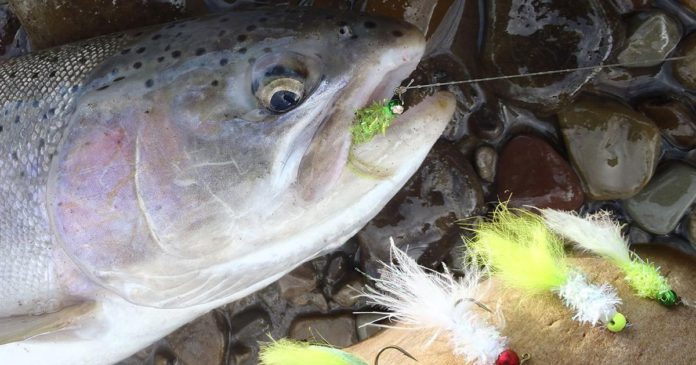Move over woolly buggers, a new fly has become my new ‘go-to’ pattern. Not that I have any complaints about my tried and true woolly buggers. The woolly bugger has earned its place as my number one fly pattern and deserves its worldwide reputation as a most productive fly pattern. The classic woolly bugger is a fundamental streamer pattern that is easy to tie, fun to customize and enticing to fish.
The versatile woolly bugger can mimic a number of aquatic creatures that fish eat. It can be fished as a streamer fly to imitate a baitfish, leech or crawfish, or dead drifted to mimic a hellgrammite or stonefly. I have had success using woolly buggers to catch a number of fish species, including steelhead, salmon, trout, bass, panfish, catfish, pike and carp.
Enter the jig fly
Like many fly anglers, I am always on a quest for a hot new fly to add to my fly box.
Each month, the Potomac Valley Fly Fishers host two fly tying events, one for beginners and another for advanced fly tyers. I demonstrated how to tie a simple, easy-to-tie jig fly pattern at a PVFF fly tying session in February 2019. At that meeting, PVFF member Don Lee remarked that the jig fly was nothing more than a small crappie jig. I agreed. Crappie jigs are deadly lures that are a staple in most spin anglers tackle boxes.
I first started using my jig flies for shad on the lower Potomac River. I found the jig fly to be just the ticket for fishing the deep water from my kayak. The jig fly is fast sinking, with plenty of flash and a sultry tail. The hook point rides upright, making it less likely to snag on rocks. Tied with tungsten bead heads and fished with sinking lines, the fly sinks quickly into the depths. The vibrant colors and flashy materials tempt strikes from the deep currents where schools of shad congregate in tributary rivers like the lower Potomac River each spring.
Initially, I wasn’t considering the other possibilities for this fly. Later that spring, I used jig flies to catch stocked trout on the Casselman River. In the summer, the jig flies proved their worth on bluegills in Cunningham Falls Lake.
Winter steelhead
When it comes to winter fishing, steelhead are on the top of my list. On a recent family trip to western New York this winter, a short spell of warm weather raised afternoon temperatures to a balmy 40 degrees. I took this brief opportunity to fish a small steelhead stream with my son, Nathaniel, and my brother Michael. We hoped to fish Cattaraugus Creek, a Lake Erie tributary, but the water was high and off-color. Fortunately, a small tributary had just enough water clarity to try our luck.
I somehow forgot to pack my fly box filled with egg patterns on this trip. Fortunately, though, I had my box of fly jigs. My brother began fishing his conventional egg flies while Nathaniel and I fished with the jig flies. Michael landed the first steelie, a good sign that the fish were present in the stream. I caught the next fish, a beautiful hen that took the dead drifted jig fly. Nathaniel managed to hook a large buck steelie that unfortunately threw the hook after a brief struggle. We had limited time to fish, but our efforts were rewarded with two fish landed and several other hook-ups. The experience elevated my respect for my fly jigs.
It’s the hook
Jig hooks are designed to ride point-up. Flies constructed on jig hooks ride in a more natural horizontal orientation than flies tied on turned down eye fly tying hooks. Consequently, jig hooks tend to hold hooked fish better. With the eye of the hook on a 45 or 90 to the shank, the line meets the fly almost directly in line with the bend where it would seat in a fish’s mouth. This greatly reduces leverage and the likelihood that a hook will pop free on a particularly violent series of head shakes.
Learning to tie
Fly tying is a great hobby that combines craft with a bit of artistic flare. Learning how to tie your own flies adds a whole new dimension to the total fishing experience. The flies I tie are similar but rarely exactly duplicate the flies I can purchase. Like most fly tyers, I customize the flies to my own specifications. Catching fish on flies of my own creation is extremely rewarding, however just the process of tying flies is great therapy for those days when I am not on the water.
Although the initial investment in a fly tying kit and basic materials is not expensive, I cannot say that you save money by tying your own flies over time. I have to admit that I have more flies than I really need because I tie my own flies. As one expands their repertoire of fly patterns and their inventory of fly tying materials grows, the costs can add up to more than the retail price of the flies you actually use to catch fish. For me, the time and costs involved are nominal compared to the rewards.
Credit: Source link






























